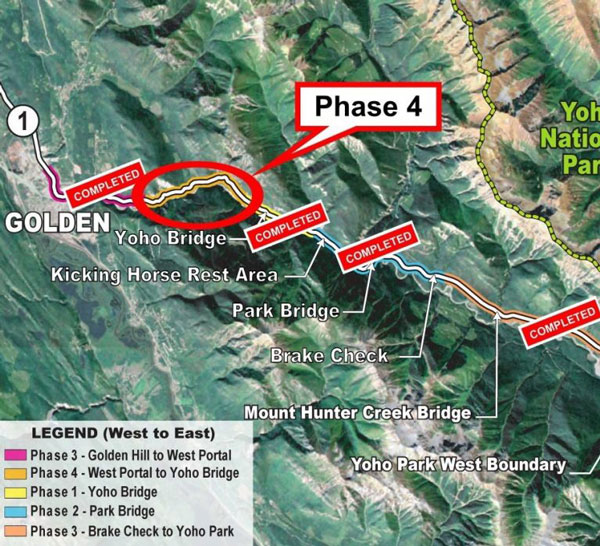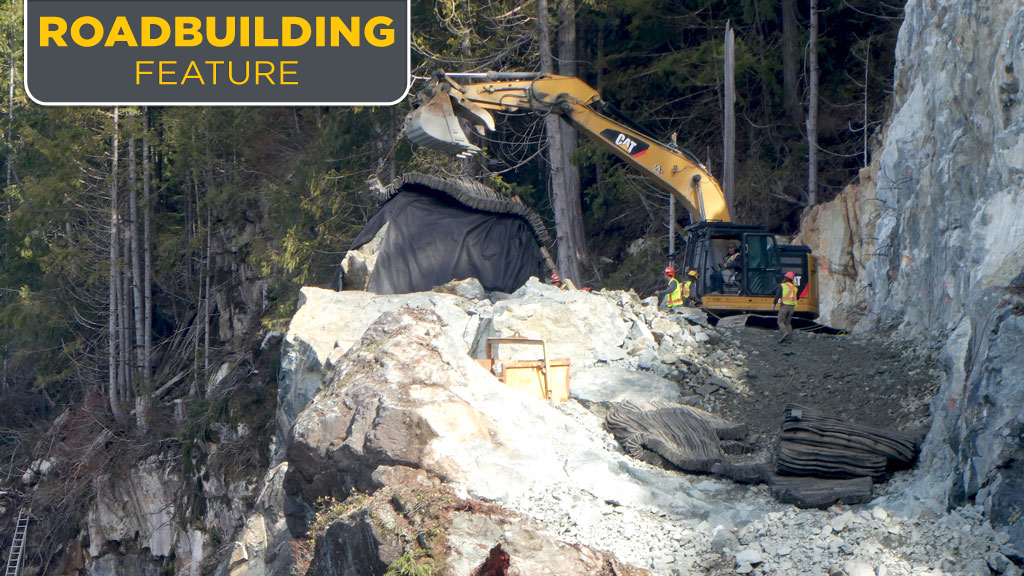The Kicking Horse Canyon’s final phase of 4.8 kilometres of Trans-Canada Highway upgrade, now underway, will see construction crews building out another lane this year to accommodate traffic on a project moving through some of B.C.’s most rugged terrain.
When complete, approximately two kilometres of the new highway section will be on elevated structures due to the steep terrain and avalanche risk.
“The work that is happening this year is construction of the east bound lane that will allow traffic to flow while the west side lane is being worked on,” said acting associate project director Kathryn Lawrence, RPF., with the Transportation Infrastructure Corporation, which is delivering the $601 million Phase 4 upgrade for the B.C. government.
“The section has some of the most challenging terrain in the province with incredible steep terrain and complex bedrock layers,” Lawrence said, which is the reason it has been left to last. The completion finishes the transformation of 26 kilometre of two-lane 1950s highway into a modern, four-lane 100 kilometre highway with two bicycle paths. The four phases are near the Town of Golden on Highway 1, a route in south eastern B.C. heavily used by commercial supply vehicles travelling to Calgary, Alberta.
The stretch of highway is also the most costly, with the $601 million budgeted – a cost that this is more than double the cumulative cost of the completed three phases ($143 million for Phase 1, $66 million Phase 2 and $53 million Phase 3). The last stretch lies between two completed portions of highway upgrades Phase 3 (Golden Hill to West Portal) and Phase 1, the upgrade Yoho Bridge. The $601-million funding is shared with the federal government contributing $215 million and the B.C. government providing the remaining $386 million.
While other phases have challenged engineering with construction innovations as seen in constructor Flatiron’s Park Bridge, the carving out of a modern highway from this rugged mountainous terrain is considered itself an engineering and construction marvel. A total of 18 bridges, walls, and viaducts are required to be built with 600 piles driven to support structures and remove 13 curves and realign the Trans-Canada Highway, said Lawrence.
In April 2017, at the time of the Phase 4 proposal call, Golden Mayor Ron Oszust told the Journal of Commerce the two-lane highway was only a ledge in the Canyon wall following the Kicking Horse River. “It is tight and narrow and the rock is not stable,” he said, adding it would be different if the rock was granite and not crumbly. Murray Tekano, major capital expenditures director for the B.C. Ministry of Transportation at the time called the project, budgeted to cost $450 million in 2017, “the most expensive highway construction per kilometre done in B.C.”
Lawrence said crews moving in to upgrade the highway face numerous challenges. “Constructing these bridges, walls and viaducts across the steep unstable terrain requires an innovative approach to the design and the construction. An extensive network of temporary access trails, trestle platforms and rope access is required to even start building the project,” Lawrence said. Specialty spider excavator are being used on steep slopes, while large crews of rock access technicians are required to install rock attenuators and walkways critical to construction.
Approximately 800,000 cubic metres of material will be excavated and blasted during construction which equates to approximately 60,000 loads of material over the life of the project. As well as working in a constrained area with traffic, construction crews have to shield against rock falls. “Much of the work is being done above the CP Rail mainland,” Lawrence said.
Construction work started on the Phase 4 upgrade began spring 2021 by the Kicking Horse Canyon Constructors (KHCC) on a design-build contract. KHCC is a joint venture comprised of lead partner Aecon (50 per cent), U.S. based Parsons Corporation (30 per cent) and Emil Anderson Construction (20 per cent). Parsons is a digitally enabled solutions provider focused on the defense, intelligence, and critical infrastructure. Lawrence said that while the three collaborate, Parson is providing the design work which will also include a median separating traffic lanes.
Under the design-build agreement, the constructor is required to factor climate change adaption into the design under the province’s 2019 issued technical circular ‘Adaption to the Impacts of Climate Change and Weather Extremes’.
“This document addresses the design requirements for climate change and is a requirement for this project,” said Lawrence.
In October 2021, crews reached a first milestone as the first concrete girders to support the deck of the Sheep Bridge were laid. Lawrence said other major bridges that will need to be built to accommodate the highway widening are Big Horn, Frenchmen’s, and Blackwall bridges.
Work is proceeding according to schedule to meet a completion date of winter 2023-24, Lawrence said. BC Infrastructure Benefits is providing employment and training opportunities for the project. BCIB director of stakeholder relations and project development Greg Johnson said the project will employ 220 over three years: 21 worker or 10 per cent are self-identified as Indigenous, 29 workers or 13 per cent are women, and 114 workers or 52 per cent of the workforce are from communities that are located within 100 kilometres of the project site.
“On the KHCP4 project, 15 per cent of the workforce, or 32 workers, have been apprentices,” he said.












Recent Comments
comments for this post are closed